Corporate Governance By Professor Cameron A. Batmanghlich (Ph.
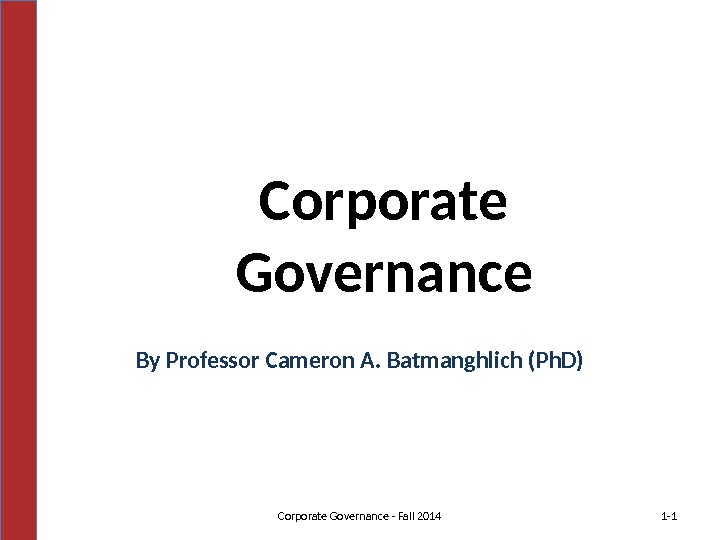

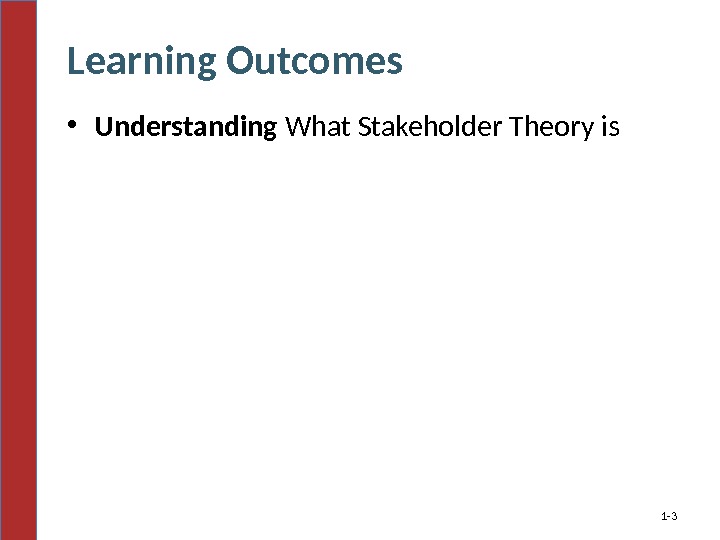
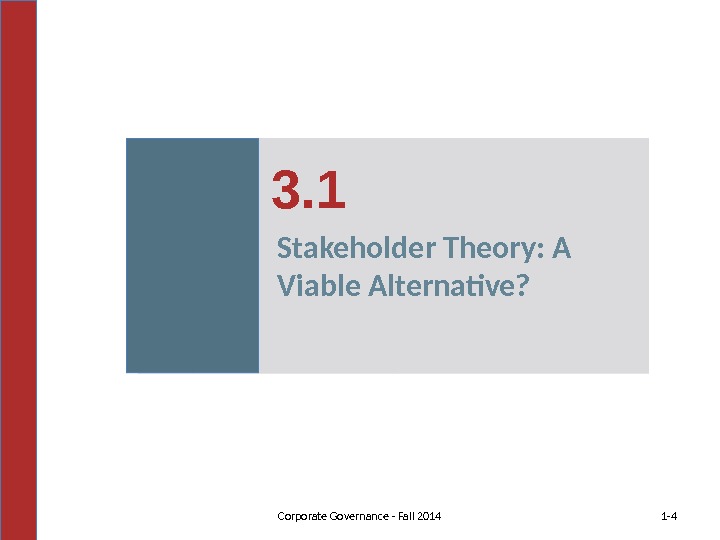

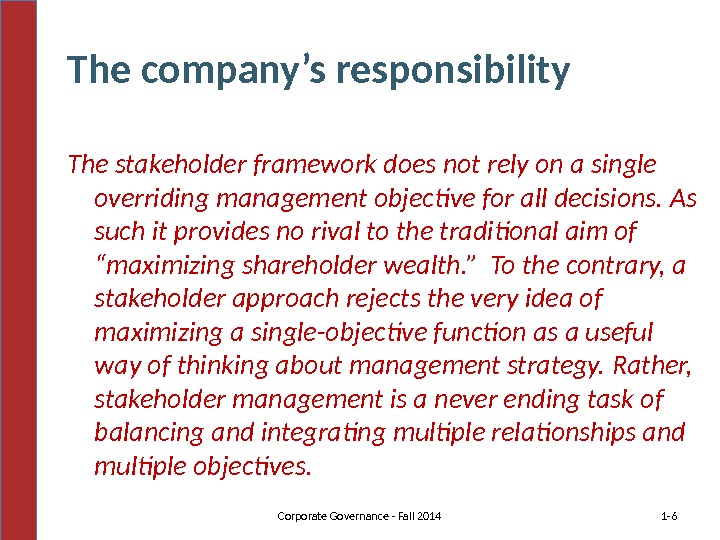
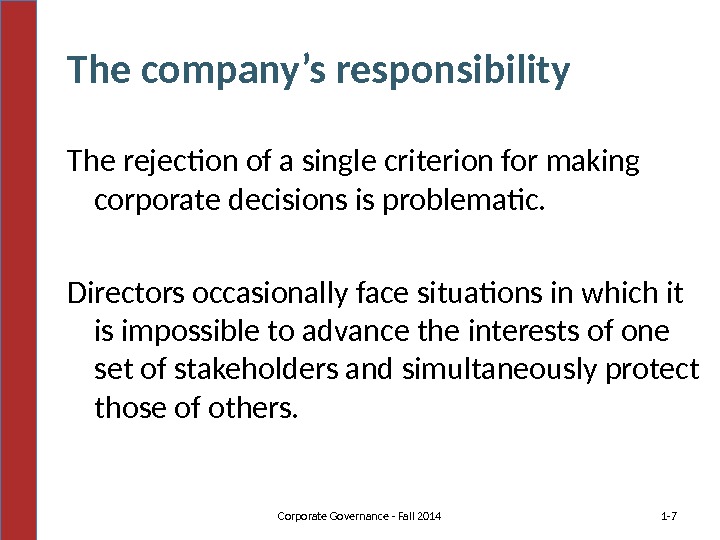
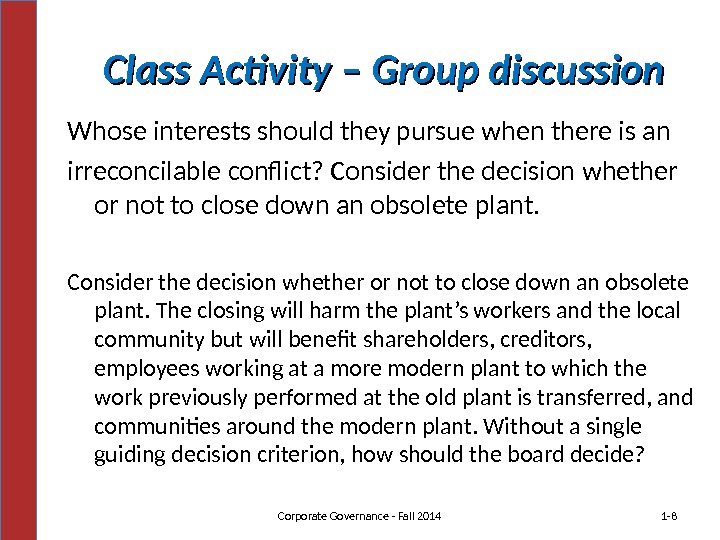



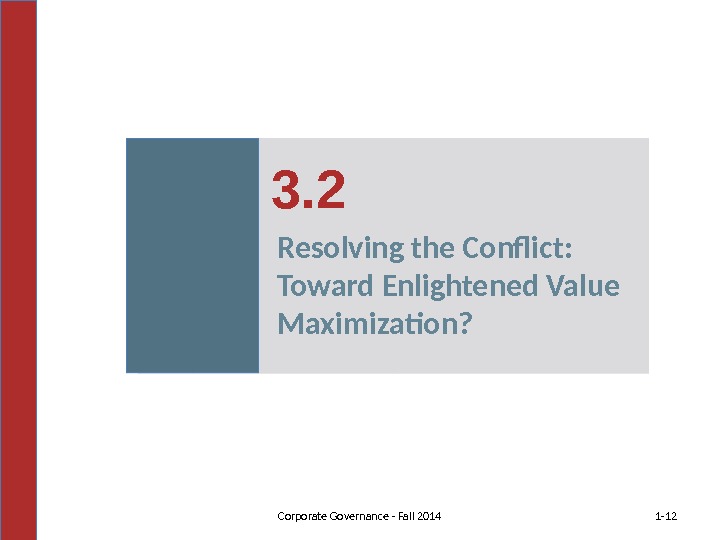
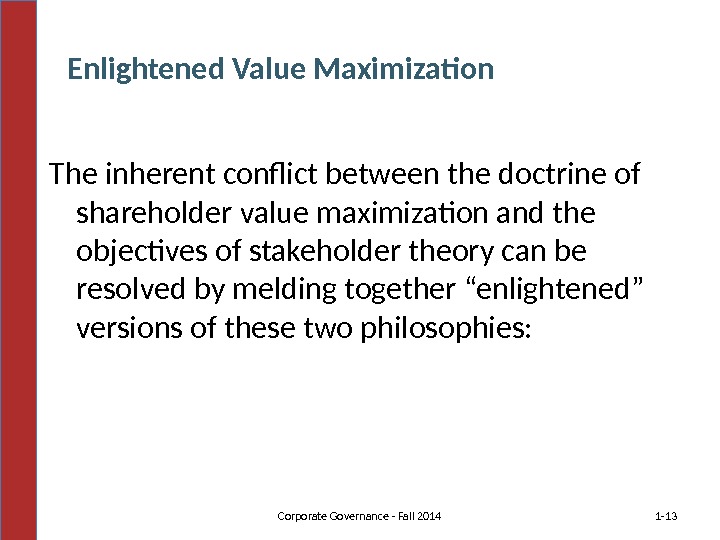
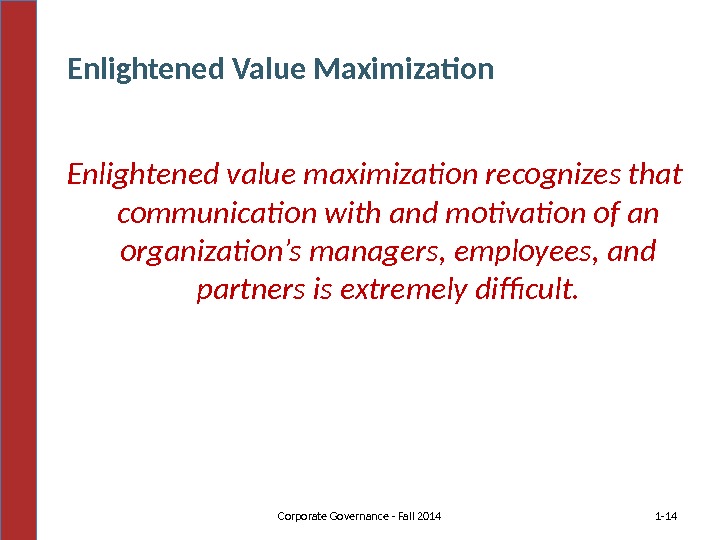
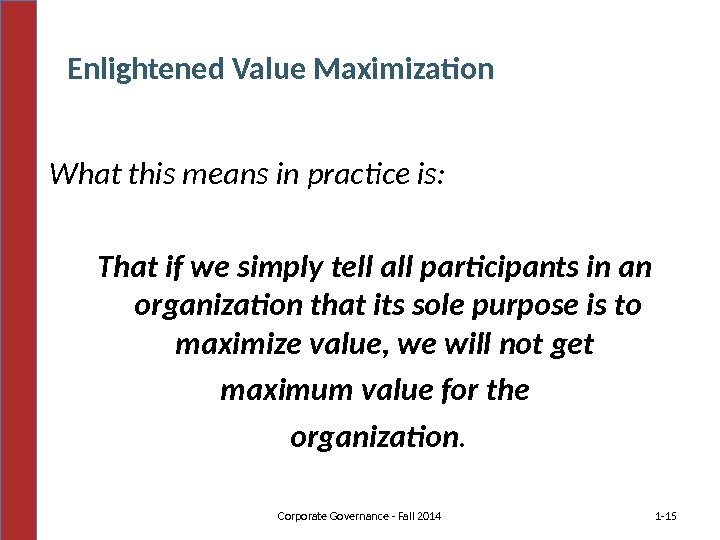
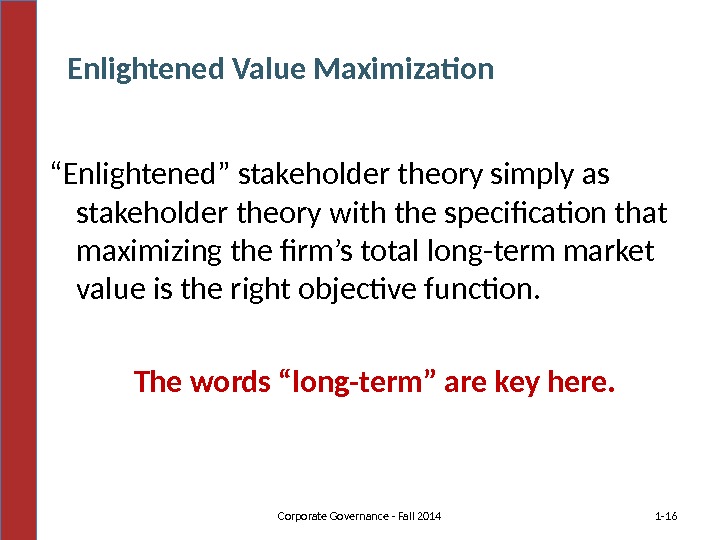
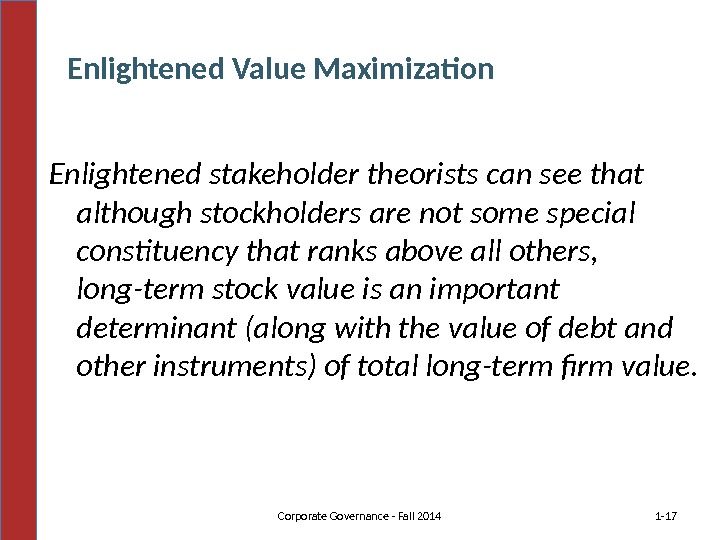



corporate_governance_-_lec._3.ppt
- Размер: 440.5 Кб
- Количество слайдов: 20
Описание презентации Corporate Governance By Professor Cameron A. Batmanghlich (Ph. по слайдам
 Corporate Governance By Professor Cameron A. Batmanghlich (Ph. D) Corporate Governance — Fall 2014 1 —
Corporate Governance By Professor Cameron A. Batmanghlich (Ph. D) Corporate Governance — Fall 2014 1 —
 Lecture Three Stakeholder Theory; Conflict Resolution 1 -1 Corporate Governance — Fall
Lecture Three Stakeholder Theory; Conflict Resolution 1 -1 Corporate Governance — Fall
 Learning Outcomes • Understanding What Stakeholder Theory is 1 —
Learning Outcomes • Understanding What Stakeholder Theory is 1 —
 1 — 43. 1 Corporate Governance — Fall 2014 Stakeholder Theory: A Viable Alternative?
1 — 43. 1 Corporate Governance — Fall 2014 Stakeholder Theory: A Viable Alternative?
 The company’s responsibility Whereas the ownership perspective, rooted in property law, provides a natural basis for the primacy of shareholder rights, the view of the corporation as a bundle of contracts permits a different view of the fiduciary obligations of corporate managers. 1 — 5 Corporate Governance — Fall
The company’s responsibility Whereas the ownership perspective, rooted in property law, provides a natural basis for the primacy of shareholder rights, the view of the corporation as a bundle of contracts permits a different view of the fiduciary obligations of corporate managers. 1 — 5 Corporate Governance — Fall
 The company’s responsibility The stakeholder framework does not rely on a single overriding management objective for all decisions. As such it provides no rival to the traditional aim of “maximizing shareholder wealth. ” To the contrary, a stakeholder approach rejects the very idea of maximizing a single-objective function as a useful way of thinking about management strategy. Rather, stakeholder management is a never ending task of balancing and integrating multiple relationships and multiple objectives. 1 — 6 Corporate Governance — Fall
The company’s responsibility The stakeholder framework does not rely on a single overriding management objective for all decisions. As such it provides no rival to the traditional aim of “maximizing shareholder wealth. ” To the contrary, a stakeholder approach rejects the very idea of maximizing a single-objective function as a useful way of thinking about management strategy. Rather, stakeholder management is a never ending task of balancing and integrating multiple relationships and multiple objectives. 1 — 6 Corporate Governance — Fall
 The company’s responsibility The rejection of a single criterion for making corporate decisions is problematic. Directors occasionally face situations in which it is impossible to advance the interests of one set of stakeholders and simultaneously protect those of others. 1 — 7 Corporate Governance — Fall
The company’s responsibility The rejection of a single criterion for making corporate decisions is problematic. Directors occasionally face situations in which it is impossible to advance the interests of one set of stakeholders and simultaneously protect those of others. 1 — 7 Corporate Governance — Fall
 Class Activity – Group discussion Whose interests should they pursue when there is an irreconcilable conflict? Consider the decision whether or not to close down an obsolete plant. The closing will harm the plant’s workers and the local community but will benefit shareholders, creditors, employees working at a more modern plant to which the work previously performed at the old plant is transferred, and communities around the modern plant. Without a single guiding decision criterion, how should the board decide? 1 — 8 Corporate Governance — Fall
Class Activity – Group discussion Whose interests should they pursue when there is an irreconcilable conflict? Consider the decision whether or not to close down an obsolete plant. The closing will harm the plant’s workers and the local community but will benefit shareholders, creditors, employees working at a more modern plant to which the work previously performed at the old plant is transferred, and communities around the modern plant. Without a single guiding decision criterion, how should the board decide? 1 — 8 Corporate Governance — Fall
 Stakeholder Theory flawed? Bainbridge (1994) argues: Ultimately, the stakeholder model is flawed because of its failure to account adequately for what he calls “managerial sin. ” The absence of a single decision-making criterion allows management to freely pursue its own self-interest by playing shareholders off against non-shareholders. 1 — 9 Corporate Governance — Fall
Stakeholder Theory flawed? Bainbridge (1994) argues: Ultimately, the stakeholder model is flawed because of its failure to account adequately for what he calls “managerial sin. ” The absence of a single decision-making criterion allows management to freely pursue its own self-interest by playing shareholders off against non-shareholders. 1 — 9 Corporate Governance — Fall
 Stakeholder Theory flawed? When management’s interests coincide with those of shareholders, management can justify its decision by saying that shareholder interests prevailed in this instance, and vice versa. The plant closing exercise is a good example: 1 — 10 Corporate Governance — Fall
Stakeholder Theory flawed? When management’s interests coincide with those of shareholders, management can justify its decision by saying that shareholder interests prevailed in this instance, and vice versa. The plant closing exercise is a good example: 1 — 10 Corporate Governance — Fall
 Stakeholder Theory flawed? Shareholders and some non-shareholder constituents benefit if the plant is closed, but other non-shareholder constituents lose. If management’s compensation is tied to firm size, we can expect it to resist any downsizing of the firm. The plant likely will stay open, with the decision being justified by the impact of a closing on the plant’s workers and the local community. In contrast, if management’s compensation is linked to firm profitability, the plant will likely close, with the decision being justified by management’s concern for the firm’s shareholders, creditors, and other constituencies that benefit from the closure decision.
Stakeholder Theory flawed? Shareholders and some non-shareholder constituents benefit if the plant is closed, but other non-shareholder constituents lose. If management’s compensation is tied to firm size, we can expect it to resist any downsizing of the firm. The plant likely will stay open, with the decision being justified by the impact of a closing on the plant’s workers and the local community. In contrast, if management’s compensation is linked to firm profitability, the plant will likely close, with the decision being justified by management’s concern for the firm’s shareholders, creditors, and other constituencies that benefit from the closure decision.
 1 — 123. 2 Corporate Governance — Fall 2014 Resolving the Conflict: Toward Enlightened Value Maximization?
1 — 123. 2 Corporate Governance — Fall 2014 Resolving the Conflict: Toward Enlightened Value Maximization?
 The inherent conflict between the doctrine of shareholder value maximization and the objectives of stakeholder theory can be resolved by melding together “enlightened” versions of these two philosophies: 1 — 13 Corporate Governance — Fall 2014 Enlightened Value Maximization
The inherent conflict between the doctrine of shareholder value maximization and the objectives of stakeholder theory can be resolved by melding together “enlightened” versions of these two philosophies: 1 — 13 Corporate Governance — Fall 2014 Enlightened Value Maximization
 Enlightened value maximization recognizes that communication with and motivation of an organization’s managers, employees, and partners is extremely difficult. 1 — 14 Corporate Governance — Fall 2014 Enlightened Value Maximization
Enlightened value maximization recognizes that communication with and motivation of an organization’s managers, employees, and partners is extremely difficult. 1 — 14 Corporate Governance — Fall 2014 Enlightened Value Maximization
 What this means in practice is: That if we simply tell all participants in an organization that its sole purpose is to maximize value, we will not get maximum value for the organization. 1 — 15 Corporate Governance — Fall 2014 Enlightened Value Maximization
What this means in practice is: That if we simply tell all participants in an organization that its sole purpose is to maximize value, we will not get maximum value for the organization. 1 — 15 Corporate Governance — Fall 2014 Enlightened Value Maximization
 “ Enlightened” stakeholder theory simply as stakeholder theory with the specification that maximizing the firm’s total long-term market value is the right objective function. The words “long-term” are key here. 1 — 16 Corporate Governance — Fall 2014 Enlightened Value Maximization
“ Enlightened” stakeholder theory simply as stakeholder theory with the specification that maximizing the firm’s total long-term market value is the right objective function. The words “long-term” are key here. 1 — 16 Corporate Governance — Fall 2014 Enlightened Value Maximization
 Enlightened stakeholder theorists can see that although stockholders are not some special constituency that ranks above all others, long-term stock value is an important determinant (along with the value of debt and other instruments) of total long-term firm value. 1 — 17 Corporate Governance — Fall 2014 Enlightened Value Maximization
Enlightened stakeholder theorists can see that although stockholders are not some special constituency that ranks above all others, long-term stock value is an important determinant (along with the value of debt and other instruments) of total long-term firm value. 1 — 17 Corporate Governance — Fall 2014 Enlightened Value Maximization
 They would recognize that value creation gives management a way to assess the tradeoffs that must be made among competing constituencies, and that it allows for principled decision making independent of the personal preferences of managers and directors. 1 — 18 Corporate Governance — Fall 2014 Enlightened Value Maximization
They would recognize that value creation gives management a way to assess the tradeoffs that must be made among competing constituencies, and that it allows for principled decision making independent of the personal preferences of managers and directors. 1 — 18 Corporate Governance — Fall 2014 Enlightened Value Maximization
 The Board of Directors: Role and Composition 1 — 19 Next Week’s Lecture:
The Board of Directors: Role and Composition 1 — 19 Next Week’s Lecture:
 THANK YOU! 1 — 20 Corporate Governance — Fall
THANK YOU! 1 — 20 Corporate Governance — Fall
